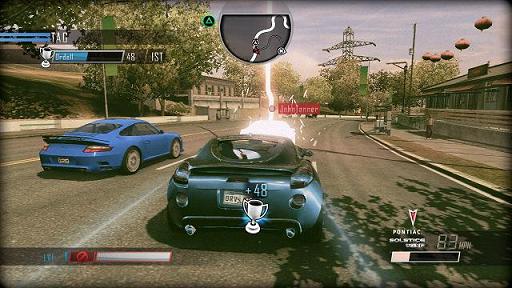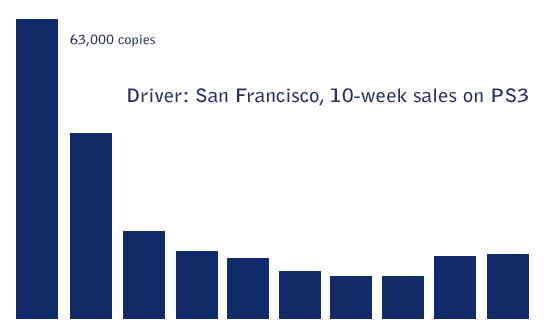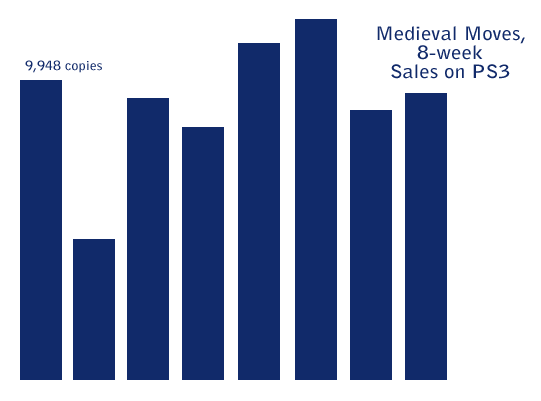In the past six months two projects of mine have been released with integral multiplayer components – Driver: San Francisco and Medieval Moves: Deadmund’s Quest. I want to quickly discuss my multiplayer experience with each of these and draw a conclusion about better ways to do multiplayer today.
Driver: San Francisco
As you may know, I’m a PC + Steam fanboy (as my Steam games list reveals). I received a free copy of Driver: San Francisco from the good folks at Reflections at release, opting for an Xbox 360 copy, because of course the PC version came out a month later. (On a more pragmatic note, games developers will be aware that when you buy your company’s games “at cost”, PC games are always the cheapest (maybe £1-2) because unlike console games, there are no automatic  fees the publisher has to pay platform owners – i.e. Sony, Microsoft, Nintendo. So PC games may be far more pirated, but there’s also a bigger profit margin for publishers – and if you include digital, that gets even bigger, since there’s no DVD-pressing, boxing or high street costs. But if you use an established digital distributor (i.e. Steam, Desura etc) that disappears in the online store owner’s cut. So it’s no wonder EA, Ubisoft etc are trying to roll out their own digital stores). But in any case, my Xbox copy was gratis, as a thank you for working on the game.
fees the publisher has to pay platform owners – i.e. Sony, Microsoft, Nintendo. So PC games may be far more pirated, but there’s also a bigger profit margin for publishers – and if you include digital, that gets even bigger, since there’s no DVD-pressing, boxing or high street costs. But if you use an established digital distributor (i.e. Steam, Desura etc) that disappears in the online store owner’s cut. So it’s no wonder EA, Ubisoft etc are trying to roll out their own digital stores). But in any case, my Xbox copy was gratis, as a thank you for working on the game.
I don’t have Xbox Live; I’m primarily a PC online gamer, and it’s a lot more expensive to buy (even pre-owned) console games and then also pay a monthly fee for multiplayer gaming. There’s a reason I don’t play MMOs! No, for me it’s Steam sales and free multiplayer all the way. (If Steam only had an affiliate program, we’d both make a killing… What a beautiful friendship that could be.)
So I played through Driver exhaustively, bought all the cars, unlocked all the Xbox achievements, but didn’t play multiplayer.
Around rolls November. The PC release hits stores, but £30 or £35 or whatever is a lot more expensive than free, so I wait for the Steam Thanksgiving sales and pick up the game half-price. The game remains awesome; I bought a wired Xbox controller specifically to play it properly on PC. Frame rate is sweet, graphics are better, I can use Fraps and post stuff on YouTube – life is good:
Unfortunately, I swiftly discover that no one is on multiplayer. Ever. To date I have not played any multiplayer Driver matches ‘in the wild’. Split-screen enables some fun, but because I want to play with my brother and his friend, a 2-player splitscreen mode doesn’t really cut it. It’s hard enough to get them to stop playing Micro Machines (seriously, that game is still addictive on Megadrive), without trying to convince one of them to sit out every match.
It turns out that there’s no one on PC multiplayer because Driver sold 375,000-odd copies on Xbox, about 510,000 copies on PS3, and only 40,000 copies on PC. At the PC’s level of sales, it starts to become statistically unlikely that anyone (especially in your time zone) wants to play multiplayer at the same moment as you.
Well, you tell me. You should have bought a PS3 copy of the game. PS3 has free multiplayer. And the PS3 version sold 510,000 copies! Problem solved, idiot.
Firstly, I’ll thank you not to call me an idiot.
Sorry.
Anyway, I’ll have you know that I didn’t own a PS3 at time of release. And if I could go back, sure, I’d probably ask for a PS3 copy instead. Maybe I’ll pick up a pre-owned one. But, speaking of PS3 games, that brings me to the other game I’m here to discuss…
Medieval Moves: Deadmund’s Quest
This was a Sony-published PS3 exclusive. Obviously, it had to be – the Playstation Move motion controls are integral (and awesome – more on this another time) for the gameplay.
Medieval Moves is a different beast when it comes to sales, though. As a brand new IP, for a relatively unloved and underrated peripheral (http://www.nextgn.com/2010/12/19/the-fight-is-grossly-underrated/, http://www.metro.co.uk/tech/837313-readers-feature-moving-against-kinect), it was never going to make the same kind of splash that Driver did (albeit a somewhat mucky splash), as a reboot of a once much-loved franchise and character. In fact, Sony did not appear to market the game at all before release. It’s slightly depressing when even most other games professionals haven’t heard of the game you’re working on.
Fascinating Sales Digression
But Sony’s strategy appears to be to publicise the game post-release. They launched ads in cinemas before family-friendly Christmas movies, and put out a TV ad in the UK around release time. What Sony realise is that the best way to capitalise on this title is to tie it in with the peripheral itself. Since only gamers who own Move can play it, it doesn’t make sense to necessarily market it to everyone who doesn’t have Move unless you think it’s such a compelling game that people will turn out in droves to buy Move just to play it. Don’t get me wrong – Medieval Moves is a fun and challenging game to play, especially on the harder difficulty settings – but unlike when I walked down to the shops as a kid with £200 in my sock to buy an N64 just so I could play Goldeneye 007, if I hadn’t worked on DQ I doubt I would have bought a Move peripheral purely to play that one game.
Marketing Digression
Since gamers won’t generally buy Move just for a game that looks cool, Sony’s strategy seems to have been to market the Move peripheral itself as a fun choice in the pre-Christmas rush when parents are thinking about what to get their children. They might market it through Deadmund’s Quest in ads like this one:
or this rather better one:
But fundamentally they’re expecting people to get Deadmund’s Quest maybe in a Playstation Move Starter Pack, or as part of a PS3 + Move console bundle.
Back to the Sales Digression
In other words, Move sales drive Deadmund’s Quest sales – not the other way around. Unfortunately, this means that, combined with the lack of pre-release publicity for the game, Medieval Moves’s first-week sales were small. The upside, though, is that sales should have a long tail, because people will keep buying the game with the hardware, until a newer Move tie-in game is released (Sorcery, perhaps?). There’s also a long tail thanks to Sony’s belated marketing push.
To show you what I mean, here’s a little chart of Driver: San Francisco’s 10-week sales I made:

Whereas here’s the 8-week sales of Medieval Moves: Deadmund’s Quest:

As you can see, relative to initial sales, Medieval Moves’ ongoing sales are far more robust. Driver had a boost around Christmas time, but other than that, sales are in decline. Medieval Moves fluctuates far more from week to week, even exceeding the initial sales a few weeks after release. Of course, the baseline absolute sales figures for Driver: San Francisco were six times greater. On the other hand, Medieval Moves was developed in just one year by a team of under 100 developers. Driver was developed over a four-year period by a combination of 3 Ubisoft studios worldwide, of which Reflections on its own had over 100 developers.
Another way of thinking about Medieval Moves’s long-tail sales is this: if you applied the same long tail sales pattern to Driver’s 10-week sales, extrapolating from a 63,000-sale initial baseline, Driver wouldn’t have sold 508,000 copies on PS3 – it would have sold 741,000.
Both games’ sales have benefitted from a positive player response and good word of mouth, although critics have whaled on Medieval Moves more than on Driver (while some of their criticisms are definitely justified, I feel that critics are failing to judge motion-controlled games according to their merits – but that’s going to be another blog post).
Back to Multiplayer
After release, I had a similar problem to Driver with Medieval Moves: Deadmund’s Quest. I was enjoying the Story Mode, but when I logged onto Multiplayer and waited to be matched up with another player, no one was there. Just like Driver, Medieval Moves has completely different multiplayer-specific game modes, so it’s sad indeed when there’s no one to play with. Thankfully, unlike Driver, Medieval Moves lets you “practice” in the multiplayer mode, so you get to play in a kind of Skirmish mode on your own, and you can do this as long as you want while waiting for another human player to join you. You might even be able to earn XP in this mode (don’t quote me on that though). In Driver, if there’s no one to play against, you’re literally just sitting on a menu screen. And you can’t even keep waiting for other players to join you – after a one-minute wait for other players, you’re kicked back out to menu. Understandably, you give up on multiplayer pretty fast.
Thankfully, due to those long-tail sales and the fact that Medieval Moves is PS3-exclusive, a few weeks after release I did start to regularly see other players joining me for multiplayer games. And schooling them was a good deal of fun (by then, I’d already honed my single player skills on Champion mode).
So how do we fix this stuff?
Hmm. All of this long post, and now I’m about to suggest such simple solutions. Well, I like the sound of my own voice, and you must too, you beautiful person. Here we go:
There’s two ways to fix these problems with multiplayer – problems which, if unchecked, are only going to get worse as the number of multiplayer games proliferates and market share is split more evenly between them due to the glut of lower-budget, more casual games:
Cross-platform Multiplayer
This is a no-brainer. If players on Xbox, PC and PS3 could all join hands and slaughter each other as one happy family, many of these dead-server issues would be resolved. Unfortunately, this is largely controlled by the console holders and not developers, which means that Microsoft, Sony etc have their own economic incentives that supersede an improved playing experience on individual games.
Because Microsoft’s Xbox Live platform is paid, and MS hosts their own servers, they have a walled garden for multiplayer and don’t want to open it up to other users and consoles who don’t generate revenue for them. This is short-sighted, because a better multiplayer experience for their players benefits their platform in the long run; but they must have crunched the numbers and figured that word-of-mouth about a great multiplayer experience would never pay back the costs of letting external clients connect, and simultaneously improving the experience for other platform holders or PC-based publishers. Plus, there are (no doubt) a few security concerns.
But, Microsoft being Microsoft, we have seen a bit of Xbox / PC cross-platform multiplayer. This doesn’t work well for shooters (keyboard + mouse being a superior control set), but it would have been great for Driver. Who wants to bet that this only applies on PC with “Games for Windows Live”, though?
Equally, thanks to the wonder of Valve and Sony making nice, Portal 2 saw the introduction of the essentially PC-based Steam platform on the Sony PS3, allowing cross-platform PS3 / PC gaming, even so far as allowing Steam community, chat and voice cross-over. It was a beautiful thing. Hopefully we will see it again in the FPS Counterstrike: Global Offensive. Cos Valve loves a challenge.
But Xbox / PS3 crossover? “My sources say no”. Anyway, all this stuff will be moot when we’re all gaming in the cloud through dumb terminals. A new console generation in 2012? – Maybe. But count on OnLive to expand rapidly this year; and I wouldn’t be surprised if we start to hear about additional cloud-based services from Steam in the next couple of years, too.
Scheduled Multiplayer
OK, so this idea is why they pay me the big bucks. The problem with organising multiplayer on a small player-base is that different people are getting on at random times, seeing no one, and then giving up on multiplayer forever.
It would be so easy for platform holders and developers to fix this. They could probably fix half of these problems by adding just a simple line of text to their multiplayer “No opponents found” screen:
finding that there’s no one on, we suggest trying again on the hour or at
half past the hour, when other players will also be logging in to look for games.
That’s it. We don’t even need timers, alarms (though they probably wouldn’t hurt), or bookings or subscription systems. If games simply told players to check back at, say, 7pm or 8pm, or even just “on the hour”, they could guide players toward connecting at the same time, and thus preserve their multiplayer viability for a longer period. They could even reduce the range of recommended gaming times in response to downloading statistics from the developer, in order to preserve multiplayer longer and tailor recommended times to existing peak usage hours.
Unfortunately, there’s no way to easily test this theory – would gamers really log back in at the recommended times? Well, indie devs – we all know you like an A/B study as much as the next guy. More, even. So why not put this text in half the copies of your multiplayer game, and omit it from the others? Let’s see if usage patterns differ.
Another 2,000 words; another single great idea. Don’t say I never give you anything.
